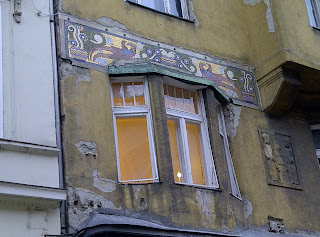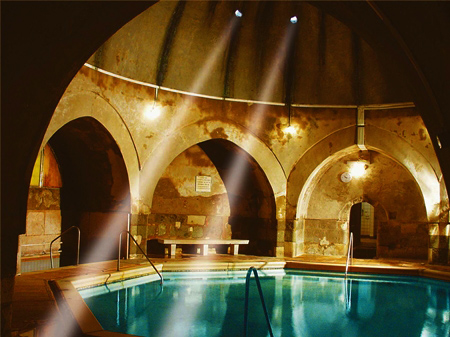Where?
When?
End-Nov / Early-Dec 2011
Why?
End-Nov / Early-Dec 2011
Why?
Prague and Budapest struck us as ‘classic’ European cities – historic old squares, rich architecture and loads of culture. The fact that both cities were home to large Christmas markets around this time of year added to the attraction - plus this would be our first true winter holiday.
Thoughts:
We thoroughly enjoyed both cities and while they had their obvious similarities - Christmas markets, beautiful architecture, communist legacy - we appreciated their differences too. Old town Prague is clearly awash in tourist euros which means the buildings look pristinely well-preserved for the most part. People refer to Prague as an 'open air museum' and you can see why given how compact and walkable the old town is with beautiful old churches, public buildings and apartment blocks all around - a bit like a mini-Paris - just not quite as grand. Budapest on the other hand is much bigger and has more of a 'city' feel with its many pockets each having a different look and feel - with some regal streets lined with stunning 19th century buildings and other areas home to a mish mash of styles as a result of significant world war destruction. But interestingly, we felt Budapest had an under-appreciated beauty - an air of 'faded' elegance perhaps - beneath the grey and sometimes peeling facades. Both cities gave us some unique experiences and we wanted to share our favourite moments here. Enjoy!
We thoroughly enjoyed both cities and while they had their obvious similarities - Christmas markets, beautiful architecture, communist legacy - we appreciated their differences too. Old town Prague is clearly awash in tourist euros which means the buildings look pristinely well-preserved for the most part. People refer to Prague as an 'open air museum' and you can see why given how compact and walkable the old town is with beautiful old churches, public buildings and apartment blocks all around - a bit like a mini-Paris - just not quite as grand. Budapest on the other hand is much bigger and has more of a 'city' feel with its many pockets each having a different look and feel - with some regal streets lined with stunning 19th century buildings and other areas home to a mish mash of styles as a result of significant world war destruction. But interestingly, we felt Budapest had an under-appreciated beauty - an air of 'faded' elegance perhaps - beneath the grey and sometimes peeling facades. Both cities gave us some unique experiences and we wanted to share our favourite moments here. Enjoy!
Our Top 5:
Budapest is known for its many thermal ‘baths’ found all over the city built on the site of natural spring waters rich in minerals. We went a bit bath-crazy, ending up trying out two of the most popular complexes on our first couple of days – Gellert and Szechenyi – both housed in beautiful late-1800 buildings. It was quite an ambience, particularly at the larger Szechenyi outdoor pools - sitting neck-deep in warm water with steam billowing across the surface adding a layer of mystique to the cold night, surrounded by lots of fellow tourists and locals who we could hardly see! The highlight though was our visit to a third spa at 6am on the morning we were leaving Budapest. Kiraly Baths, a 16th century Turkish bath, had quite a different setup with one octagonal shaped pool in the middle of a dimly-lit room under a domed ceiling, with four smaller pools, each at different temperatures, in each corner. Given the time of day, we seemed to be among mostly locals – mainly big-bellied Hungarian men shifting from pool to pool chatting up a storm with their voices booming around the room! Was what we thought to be a therapeutic and meditative morning soak actually a big old social session? After a half-hour or so of relaxing in one of the warmer pools stretching out my legs and arms, I looked to V and said, "Now this is a lifestyle I could get used to!"
2
2. Coffee House Culture
Being the ‘sweet extremists’ that we are, sitting in the old-world coffee houses of Prague and Budapest were just our kind of thing. After a long day of touring Prague castle and strolling along the river we ended up at Café Savoy – an iconic establishment started in 1893. A bright and airy room, chandelier-ed high ceiling, immaculately dressed wait staff and a menu full of classic cakes – it’s not hard to imagine the elite of another era enjoying an afternoon at Café Savoy. What I found surprising was that, despite the classic and somewhat formal look, the place actually had a very casual air about it. There were a few couples chatting quietly, a young woman enjoying a glass of wine pouring over some papers, another man reading the newspaper – everyone just enjoying a peaceful moment in this coffee house oasis.
3. Christmas Markets
Being in Europe you cannot escape the
festive spirit of Christmas – streets are covered in lights, holiday music
booms in every store, decorated trees adorn every corner and the feeling of
traditions and family time permeates the air. In fact, one of our main reasons
to go to Eastern Europe during the winter was their Christmas spirit and
specifically their Christmas markets. In
the heart of both Prague and Budapest, with the backdrop of cobble streets,
stone churches and old 13th century buildings, the giant Christmas
trees, wooden stalls full local handicrafts and the smell of freshly cooking
cinnamon rolls or sweet taste of hot spice and brandy-filled mulled wine felt
simply magical. We must have gone to the
market every day and were lucky to be there for the tree lighting ceremony in
Prague where we snuggled with over three thousand people, in sub-zero
temperatures, counting down, in Czech no less, the seconds to a splendid light
show marking the start of Christmas.



4. Culture Vultures
Both cities appeared rich in cultural heritage, with people handing out flyers advertising all types of concerts around town, in churches and in prominent buildings. We enjoyed a strings orchestra performance at the Municipal House in Prague - 90 minutes of the classical bests – a couple of which we recognized. In Budapest, we tried our hand at our first opera in the city’s stunning gold-guilded opera house built in 1886. In our very own private booth, we sat in awe of the building’s decorative beauty, virtually every inch of the ceiling and walls were covered in ornate design and frescos. Made me wonder how this generation – seemingly so focused on music, art and culture – got so badly caught up in war and destruction just a few years later? The opera itself was a bit tough to follow, what with the singing being in Italian and the sub-titles in Hungarian – leaving us to Wikipedia the English synopsis on our cell phone at the intermission!
5. Communism Walking Tour

The effect of world wars and communism can be seen throughout Budapest. Even today, a lot of the damage done to the city has not been repaired for lack of funds and many building facades are left dilapidated or bullet ridden.
A local group offered free walking tours to people interested in learning about life under communism. Our guide, a 40-year woman named Agnes, a "Budapester" with a positive yet pragmatic attitude, took us on a walk of areas around the city centre feeding us lots of information about the historical and political context of communism, but also stories from her own childhood growing up pre-1989. While she lamented the current challenges of post-communism Hungary (corruption mainly), she was convinced freedom was worth it and while aware of the challenges, remained optimistic about the future given this was still early days in their democratic experiment. We heard lots of interesting snippets of life under communism - from how easy and cheap it was to travel across Eastern Europe but highly restrictive to go West... how doctors were paid not much more than factory workers to ensure 'equality'... how people could either have a career or openly practice their religion but not both... how apartments were deliberately built with small kitchens to discourage socialising which could lead to ideas for change - she painted a pretty full picture of how most aspects of life were so controlled. It was really eye-opening hearing first-hand about daily life under a socio-economic system so different from our own.
Hidden Gems - a few sites that deserve a mention
- Spanish Synagogue – tucked in the Jewish quarter of Prague sits this beautiful synagogue in which every surface is covered by elaborate Islamic-style patterns in bright golds, reds and blues adopted by the ‘Moorish’ (North African Muslim) inspired synagogues in Spain.

- Saxlehner House – This was the residence belonging to András Saxlehner, a rich 19th century businessman who sold mineral water from natural thermal springs he owned. Although the building is under renovation, we walked right in, past the workers and scaffolding, into the dusty hallways where we found original fresco’s depicting all aspects of the mineral water business including women leisurely bathing in thermal baths. Funnily we only saw the fresco's when the camera flash hit them as they were completely covered in dust! Apparently he also requested the architect to incorporate his initials "AS" as much as possible so K and I had a fun time trying to spot them :)


- St. George's Basilica is the oldest church building within the Prague Castle complex. Founded in 915 this church has a very different feel than others. The inside is minimalist and serene with stone walls, a high wood paneled ceiling, a few statues and a beautiful fresco that adorns the stone dome (the only thing with colour). This church feels like it was meant purely for worship.
- Surprisingly Good Food! We'll be honest - our expectations were pretty low. But in Budapest we had four good dinners in four nights and were amazed by the quality, creativity and value at the restaurants - we had everything from modern Hungarian to casual French cuisine. Our highlight was a classic beef goulash with homemade noodle bits - a dish so nice, we went to the same place twice.

- Sunrise on Charles Bridge - We absolutely loved this cobble stone bridge connecting the old city to the main cathedral across the river. It is lined with stone statues depicting different religious events meant to encourage the masses to come back to god. We got up at the crack of dawn (literally) to see the sun rise over the city - although freezing, it was amazing having the bridge almost to ourselves and seeing the sun peak up from behind the buildings.






























very nice blog <3
ReplyDelete